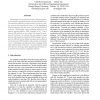Free Online Productivity Tools
i2Speak
i2Symbol
i2OCR
iTex2Img
iWeb2Print
iWeb2Shot
i2Type
iPdf2Split
iPdf2Merge
i2Bopomofo
i2Arabic
i2Style
i2Image
i2PDF
iLatex2Rtf
Sci2ools
104
Voted
ICPR
2004
IEEE
2004
IEEE
Nearest Neighbor Ensemble
Recent empirical work has shown that combining predictors can lead to significant reduction in generalization error. The individual predictors (weak learners) can be very simple, such as two terminal-node trees; it is the aggregating scheme that gives them the power of increasing prediction accuracy. Unfortunately, many combining methods do not improve nearest neighbor (NN) classifiers at all. This is because NN methods are very robust with respect to variations of a data set. In contrast, they are sensitive to input features. We exploit the instability of NN classifiers with respect to different choices of features to generate an effective and diverse set of NN classifiers with possibly uncorrelated errors. Interestingly, the approach takes advantage of the high dimensionality of the data. The experimental results show that our technique offers significant performance improvements with respect to competitive methods.
Related Content
| Added | 09 Nov 2009 |
| Updated | 09 Nov 2009 |
| Type | Conference |
| Year | 2004 |
| Where | ICPR |
| Authors | Bojun Yan, Carlotta Domeniconi |
Comments (0)

